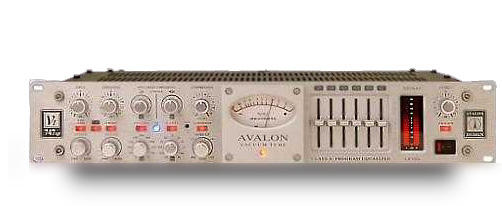
| REVIEWS: Studio Sound, December 1999 | |
|
Vt-747sp Stereo Opto-Compressor / Program Equalizer 
Like good and evil, "clean" and "valve" sounds both have something to offer. Dave Foister finds a temptation at his fingertips. Avalon's range of distinctive signal processors continues to grow with the Vt-747SP, a compressor with EQ intended for overall stereo treatment. The range is distinctive both in styling and in design approach, and the 747 share both these characteristics with the 737 Direct Signal Path. The cosmetic style comes from a thick aluminum front panel featuring a recessed panel, a bolted-on meter housing, and big metal knurled knobs. The layout is clear and well labeled, which is just as well since the manual was not sent in my package. One cosmetic niggle: the switches are back-lit transparent push-buttons, and the lights are so far back inside that they can make adjacent switches look as though they're on if you're not directly in front of them. Avalon's distinctive electronic characteristic is the fondness for class-A operation and discrete solid-state circuitry. The 747 shares the 737?s hybrid approaches, building the compressor around a valve stage and opto-couplers while remaining solid-state elsewhere. This time the use of the valves is optional, selected by a switch marked TSP for Tube Signal Path, giving a useful facility to choose the character that best suits the job Avalon generally puts one or two unusual features in as well, and the compressor here is no exception. In some respects it's simple enough, with continuously variable Attack and Release times, click-stop pots for Threshold and Ratio controls, and variable gain make-up. The single huge VU meter in the middle shows the amount of gain reduction, and is augmented by a blue LED buried among the controls. The time parameters are completely uncalibrated, marked only from Slow to Fast, and are so forgiving that they could be signal-dependent, although Avalon does not say so. Everything else is calibrated in the expected way, although the Threshold is unusual in having most of it's rotational range above zero and a relatively small arc below. This fits with it's mixing-mastering role as subtle treatment of the upper reaches of the dynamics is more likely to be required than serious crunching of the lower level stuff. All of this is simplicity itself to set up, and the ranges of the controls are such that gentle unobtrusive smoothing is as easy as aggressive dynamic contouring. The extra element within the compressor section is a couple of swept EQ bands sitting in the side chain. These are labeled Side-Chain Contour, and are broad filters with 15dB of boost and cut and overlapping frequency ranges. They can be switched in and out as a pair, and also allow for the signal through them to be monitored, although this can give rise to some initial confusion. The key is that as they are controlling the contour of the threshold, increasing their gain settings raises the threshold within the band so that the compressor does less. Because of this, when the side chain is monitored, what looks like a pair of semi-parametrics seems to be working back to front, as turning the gain down to -15 turns the band up as heard via the monitor path and makes the compressor work much harder in that range. I'm not sure why Avalon would have decided to do it that way, as most of us are used to simply boosting a frequency band in the side chain to make it compress more, but once you get the hang of it it's okay, and the fact that the knobs seem at first sight to work backwards does not detract from the features presence. There's more to come, also in the EQ area, but quite different from what the 737 offers. To the right of the meter is a 6-band graphic, with three bell-shaped mid bands, a shelving LF band and not one but two shelving bands, one mid range at 5khz and one up with the bats at 32khz. Boost and cut is in single figures for all but the outer two bands, which run to +/-16dB, although all are shown on the panel as +/-3. Subtlety is the aim here, and it is indeed a very sweet and smooth EQ, just right for a little tweak of a mix. As with other Avalon Eq's the apparently ultra-sonic band is actually very useful for a little bit of shine or softness. Like the 737, the747 has a switch for placing the graphic pre the compressor stage, adding further detailed tailoring possibilities. The final area of the panel contains a pair of red LED meters (so bright and fast that they look like flickering flames when they're running), an EQ in-out switch and a final output level control. The sonic qualities of the 747 are impressive indeed, achieving the unlikely feat of two paths that both sound neutral and accurate and yet are different. The valve path adds a certain thickness and size to the sound while the other is the more open and transparent, yet both are quiet, flat and clean. The subtle difference, along with the flexibility and fine control of the ganged stereo processing, makes it a very desirable mastering compressor indeed. Back to Reviews Index & User List |
Tel: +1 949 492
2000
©2023 Avalon Design USA LLC